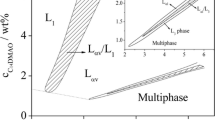Abstract
To develop a convenient and reversible strategy for phase separation and re-emulsification of surfactant-based emulsions, we established a method for pH switching of emulsions formed from a pH-switchable anionic surfactant, potassium dodecyl seleninate (C12SeO2K). Upon acidification, C12SeO2K was protonated to give a precipitate of dodecyl seleninic acid (C12SeO2H); upon basification, C12SeO2H was neutralized restore C12SeO2K. The pH-switchable window of the emulsion thus obtained was a pH range of 7 to 8. Reversible changes in both interfacial tension by ~10.2 mN m−1, as well as the mechanical, steric, and/or electrical barriers formed by C12SeO2K at the interface of the oil–aqueous solution account for the fully reversible phase separation and re-emulsification of the C12SeO2K-based emulsions. A stable emulsion (i.e. the time needed to separate 1 mL of H2O from 6 mL of emulsion at 25 °C is larger than 1 h) could be cycled at least 25 times when the pH was varied between 7 and 8.





Similar content being viewed by others
References
Sastre AM, Kumar A, Shukla JP, Singh RK. Improved techniques in liquid membrane separations: an overview. Sep Purif Rev. 1998;27:213–98.
Liu Y, Jessop PG, Cunningham M, Eckert CA, Liotta CL. Switchable surfactants. Science. 2006;313:958–60.
Brown P, Butts CP, Eastoe J. Stimuli-responsive surfactants. Soft Matter. 2013;9:2365–74.
Jiang J, Zhu Y, Cui Z, Binks BP. Switchable Pickering emulsions stabilized by silica nanoparticles hydrophobized in situ with a switchable surfactant. Angew Chem. 2013;125:12599–602.
Liu H, Wang C, Zou S, Wei Z, Tong Z. Simple, reversible emulsion system switched by pH on the basis of chitosan without any hydrophobic modification. Langmuir. 2012;28:11017–24.
Takahashi Y, Fukuyasu K, Horiuchi T, Kondo Y, Stroeve P. Photoinduced demulsification of emulsions using a photoresponsive gemini surfactant. Langmuir. 2014;30:41–7.
Takahashi Y, Koizumi N, Kondo Y. Active demulsification of photoresponsive emulsions using cationic-anionic surfactant mixtures. Langmuir. 2016;32:683–8.
Jia K, Cheng Y, Liu X, Li X, Dong J. Thermal, light and pH triple stimulated changes in self-assembly of a novel small molecular weight amphiphile binary system. RSC Adv. 2015;5:640–2.
Viricel W, Mbarek A, Leblond J. Switchable lipids: conformational change for fast pH-triggered cytoplasmic delivery. Angew Chem Int Ed. 2015;54:12743–7.
Zhang Y, An P, Liu X. Bell-shaped sol-gel-sol conversions in pH-responsive worm-based nanostructured fluid. Soft Matter. 2015;11:2080–4.
Lv J, Qiao W, Xiong C. Synthesis and surface properties of a pH-regulated and pH-reversible anionic gemini surfactant. Langmuir. 2014;30:8258–67.
Lu H, Xue M, Wang B, Huang Z. pH-regulated surface property and pH-reversible micelle transition of a tertiary amine-based Gemini surfactant in aqueous solution. Soft Matter. 2015;11:9135–43.
Yan Z, Dai C, Zhao M, Zhao G, Li Y, Wu X. pH-switchable wormlike micelle formation by N-alkyl-N-methylpyrrolidinium bromide-based cationic surfactant. Colloids Surf A. 2015;482:283–9.
Zhu Y, Jiang J, Cui Z, Binks BP. Responsive aqueous foams stabilized by silica nanoparticles hydrophobised in situ with a switchable surfactant. Soft Matter. 2014;10:9739–45.
Zhang Y, Zhang Y, Wang C, Liu X, Fang Y, Feng Y. CO2-responsive microemulsion: reversible switching from an apparent single phase to near-complete phase separation. Green Chem. 2016;18:392–6.
Scott LM, Robert T, Harjani JR, Jessop PG. Designing the head group of CO2-triggered switchable surfactants. RSC Adv. 2012;2:4925–31.
Zhang J, Han B. Supercritical or compressed CO2 as a stimulus for tuning surfactant aggregations. Acc Chem Res. 2013;46:425–33.
Ceschia E, Harjani JR, Liang C, Ghoshouni Z, Andrea T, Brown RS, Jessop PG. Switchable anionic surfactants for the remediation of oil-contaminated sand by soil washing. RSC Adv. 2014;4:4638–45.
Wang G, Kang Y, Tang B, Zhang X. Tuning the surface activity of Gemini amphiphile by the host-guest interaction of cucurbit[7]uril. Langmuir. 2015;31:120–4.
Brown P, Bromberg L, Rial-Hermida MI, Wasbrough M, Hatton TA, Alvarez-Lorenzo C. Magnetic surfactants and polymers with gadolinium counterions for protein separations. Langmuir. 2016;32:699–705.
Brown P, Bushmelev A, Butts CP, Cheng J, Eastoe J, Grillo I, Heenan RK, Schmidt AM. Magnetic control over liquid surface properties with responsive surfactants. Angew Chem Int Ed. 2013;51:2414–6.
Saji T, Hoshino K, Aoyagui S. Reversible formation and disruption of micelles by control of the redox state of the head group. J Am Chem Soc. 1985;107:6865–8.
Tsuchiya K, Orihara Y, Kondo Y, Yoshino N, Ohkubo T, Sakai H, Abe M. Control of viscoelasticity using redox reaction. J Am Chem Soc. 2004;126:12282–3.
Fan H, Han F, Liu Z, Qin L, Li Z, Liang D, Ke F, Huang J, Fu H. Active control of surface properties and aggregation behavior in amino acid-based Gemini surfactant systems. J Colloid Interface Sci. 2008;321:227–34.
Zhang Y, Kong W, Wang C, An P, Fang Y, Feng Y, Qin Z, Liu X. Switching wormlike micelles of selenium-containing surfactant using redox reaction. Soft Matter. 2015;11:7469–73.
Zhang Y, Yang C, Guo S, Chen H, Liu X. Tandem triggering of wormlike micelles using CO2 and Redox. Chem Commun. 2016;52:12717–20.
Zhang Y, Chen H, Liu X, Zhang Y, Fang Y, Qin Z. Effective and reversible switching of emulsions by an acid/base-mediated redox reaction. Langmuir. 2016;32:13728–35.
Chu W. Remediation of contaminated soils by surfactant-aided soil washing. Pract Period Hazard Toxic Radioact Waste Manage. 2003;7:19–24.
Zhang Y, An P, Liu X. A “worm”-containing viscoelastic fluid based on single amine oxide surfactant with an unsaturated C22-tail. RSC Adv. 2015;5:19135–44.
Rosen MJ. Surfactants and interfacial phenomena. 3rd ed. New Jersey: Wiley; 2004. p. 122–7.
Acknowledgements
This work was financially supported by the National Natural Science Foundation of China (Grant nos. 21673103, 21503094), the Qinglan Project of Jiangsu Province, and Zhejiang Zanyu Technology Co. Ltd., People’s Republic of China.
Author information
Authors and Affiliations
Corresponding author
Electronic supplementary material
Below is the link to the electronic supplementary material.
About this article
Cite this article
Chen, H., Zhang, Y., Liu, X. et al. Reversibly pH-Switchable Anionic-Surfactant-Based Emulsions. J Surfact Deterg 20, 1115–1120 (2017). https://doi.org/10.1007/s11743-017-1981-5
Received:
Accepted:
Published:
Issue Date:
DOI: https://doi.org/10.1007/s11743-017-1981-5




